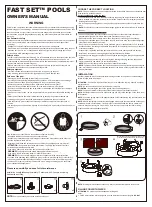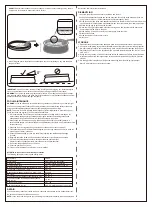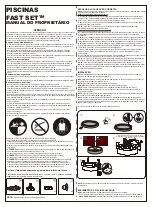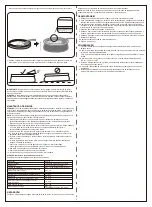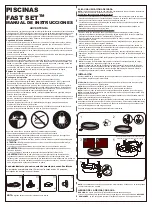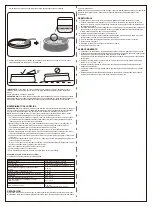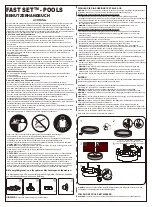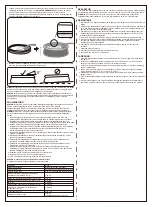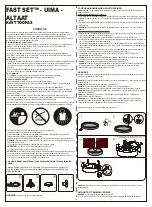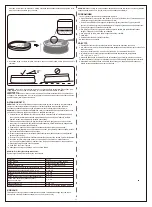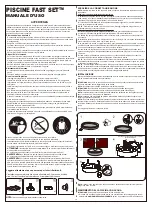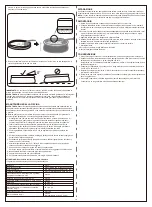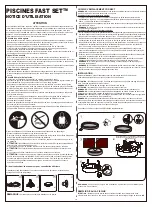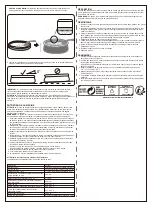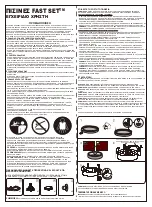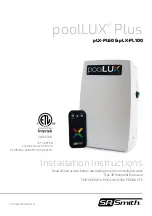
3
POOL MAINTENANCE
WARNING:
If you do not adhere to the maintenance guidelines covered herein, your health might
be at risk, especially that of children. Pool water treatment is essential for the safety of the users.
Using chemicals inappropriately will cause property damage and personal injury.
NOTE:
The pump is used to circulate the water and to filter small particles. In order to keep your
pool water clean and hygienic, you must also add chemicals.
1. It is recommended not to fill the pool with catchment water, drilling water, or drainage well
water: these waters generally contain polluted organic substances including nitrates and
phosphates. Filling pools with water from the public network is advised.
2. Always keep your pool clean and apply the correct pool chemicals. Unsanitary water is a
serious health hazard. It is recommended to use disinfectant, flocculant, acid or alkali chemicals
to treat your pool.
3. Clean the PVC liner regularly with non-abrasive brushes or a pool vacuum cleaner.
4. Throughout the season, the water filtration system must run long enough each day to clean the
entire volume of water in the pool.
5. Check the filter cartridge (or sand in a sand filter) regularly and replace dirty cartridges
(or sand).
6. Regularly check the screws, bolts and all the metal parts for rust. Replace if necessary.
7. If it rains, check that the water level is not higher than the specified level.
If water exceeds the specified levels, drain the pool to the specified level.
8. Do not use the pump when the pool is in use.
9. Cover the pool when not in use.
10. For pool water treatment, the pH value is very important.
ATTENTION: Do not leave the drained pool outside.
The following parameters ensure good quality water
REPAIR
Check pool for any leaks from valves or seams, check the ground cloth for any evident water loss.
Do not add chemicals until this has been done.
NOTE:
In the event of a leak, patch your pool using the underwater adhesive repair patch
provided.
Refer to the FAQs for further information.
DISMANTLING
1. Unscrew the drain valve cap counter-clockwise and remove.
2. Connect the adaptor to the hose and put the other end of the hose in the area where you are
going to drain your pool. (Check local regulations for drainage by-laws).
3. Screw the control ring of the hose adaptor clockwise onto the drain valve. The drain valve will be
open and water will start to drain automatically. Open the drain valve to the maximum position.
4. Deflate the top ring by squeezing the air valve.
5. When the top ring is fully deflated, press the top ring down, and tilt it to drain the pool easily.
Completely drain the water in the pool.
6. When draining is finished, unscrew the control ring to close the valve.
7. Disconnect the hose.
8. Screw the cap back onto the drain valve.
9. Air dry pool.
STORAGE
1. Please remove all the accessories and spare parts of the pool and store them clean and dry.
2. Once pool is completely dry, sprinkle with talcum powder to prevent pool from sticking together,
fold pool carefully. If pool is not completely dry, mold may result and will damage the pool liner.
3. Store liner and accessories in a dry place with a moderate temperature between 5ºC / 41ºF and
38ºC / 100ºF.
4. During the rainy season, pool and accessories should be stored as per above instructions also.
5. Improper draining of the pool might cause serious personal injury and/or damage to personal
property.
6. We strongly recommend the pool is disassembled during the off season (winter months).
Store in a dry location out of children’s reach.
OVERFILL
as this could cause the pool to collapse. In times of heavy rainfall you may need to
empty some of the water to ensure the level is correct.
2. When filling the pool is completed, check that the water is not collecting on any side to ensure
the pool is level.
IMPORTANT:
If pool is not level, drain water and re-level ground by digging out. Never attempt to
move the pool with water in it, serious personal injury or damage to the pool may result.
WARNING:
Your pool may contain a great deal of pressure. If your pool has any bulge or uneven
side, then the pool is not level, the sides may burst and the water may discharge suddenly causing
serious personal injury and/or damage to property.
Parameters
Values
Water clarity
clear view of the pool bottom
Colour of the water
no colour should be observed
Turbidity in FNU/NTU
max. 1,5 (preferably less than 0,5)
Nitrate concentration above that of fill water in mg/l
max. 20
Total organic carbon (TOC) in mg/l
max. 4,0
Redox potential against Ag/AgCI 3,5 m KCl in mV
min. 650
pH value
6,8 to 7,6
Free active chlorine (without cyanuric acid) in mg/l
0,3 to 1,5
Free chlorine used in combination with cyanuric
acid in mg/l
1,0 to 3,0
Cyanuric acid in mg/l
max. 100
Combined chlorine in mg/l
max. 0,5 (preferably close to 0,0 mg/l)
.
0°


